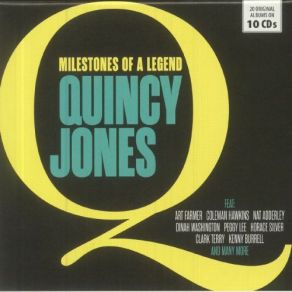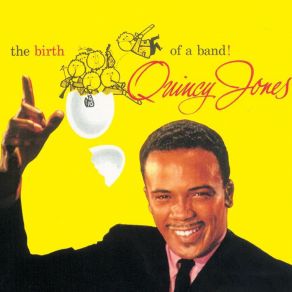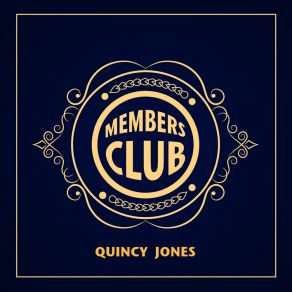Quincy Jones
Wikimp3 information about the music of Quincy Jones. On our website we have 70 albums and 70 collections of artist Quincy Jones. You can find useful information and download songs of this artist. We also know that Quincy Jones represents Jazz genres.
Biography
[Edit]In a musical career that has spanned six decades, Quincy Jones has earned his reputation as a renaissance man of American music. Jones has distinguished himself as a bandleader, a solo artist, a sideman, a songwriter, a producer, an arranger, a film composer, and a record label executive, and outside of music, he's also written books, produced major motion pictures, and helped create television series. And a quick look at a few of the artists Jones has worked with suggests the remarkable diversity of his career — Miles Davis, Frank Sinatra, Count Basie, Lesley Gore, Michael Jackson, Peggy Lee, Ray Charles, Paul Simon, and Aretha Franklin.
Jones was born in Chicago, Illinois, on March 14, 1933. When he was still a youngster, his family moved to Seattle, WA, and he soon developed an interest in music. In his early teens, Jones began learning the trumpet, and started singing with a local gospel group. By the time he graduated from high school in 1950, Jones had displayed enough promise to win a scholarship to Boston-based music school Schillinger House (which later became known as the Berklee School of Music). After a year at Schillinger, Jones relocated to New York City, where he found work as an arranger, writing charts for Count Basie, Cannonball Adderley, Tommy Dorsey, and Dinah Washington, among others. In 1953, Jones scored his first big break as a performer; he was added to the brass section of Lionel Hampton's orchestra, where he found himself playing alongside jazz legends Art Farmer and Clifford Brown. Three years later, Dizzy Gillespie tapped Jones to play in his band, and later in 1956, when Gillespie was invited to put together a big band of outstanding international musicians, Diz chose Quincy to lead the ensemble. Jones also released his first album under his own name that year, a set for ABC-Paramount appropriately entitled This Is How I Feel About Jazz.
In 1957, Jones moved to Paris in order to study with Nadia Boulanger, an expatriate American composer with a stellar track record in educating composers and bandleaders. During his sojourn in France, Jones took a job with the French record label Barclay, where he produced and arranged sessions for Jacques Brel and Charles Aznavour, as well as traveling American artists, including Billy Eckstine and Sarah Vaughan. Jones' work for Barclay impressed the management at Mercury Records, a American label affiliated with the French imprint, and in 1961, he was named a vice president for Mercury, the first time an African-American had been hired as an upper-level executive by a major U.S. recording company. Jones scored one of his first major pop successes when he produced and arranged "It's My Party" for teenage vocalist Lesley Gore, which marked his first significant step away from jazz into the larger world of popular music. (Jones also freelanced for other labels on the side, including arranging a number of memorable Atlantic sides for Ray Charles.) In 1963, Jones began exploring what would become a fruitful medium for him when he composed his first film score for Sidney Lumet's controversial drama The Pawnbroker; he would go on to write music for 33 feature films, including In Cold Blood, In the Heat of the Night, Bob & Carol & Ted & Alice, and The Getaway. In 1964, Jones' work with Count Basie led him to arrange and conduct sessions for Frank Sinatra's album It Might as Well Be Swing, recorded in collaboration with Basie and his orchestra; he also worked with Sinatra and Basie again as an arranger for the award-winning Sinatra at the Sands set, and would produce and arrange one of Sinatra's last albums, L.A. Is My Lady, in 1984.
While Jones maintained a busy schedule as a composer, producer, and arranger through the 1960s, he also re-emerged as a recording artist in 1969 with the album Walking in Space, which found Jones recasting his big-band influences within the framework of the budding fusion movement and the influences of contemporary rock, pop, and R&B sounds. The album was a commercial and critical success, and kick started Jones' career as a recording artist. At the same time, he began working more closely with contemporary pop artists, producing sessions for Aretha Franklin and arranging strings for Paul Simon's There Goes Rhymin' Simon, and while Jones continued to work with jazz artists, many hard-and-fast jazz fans began to accuse Jones of turning his back on the genre, though Jones always contended his greatest allegiance was to African-American musical culture rather than any specific style. (Jones did, however, make one major jazz gesture in 1991, when he persuaded Miles Davis to revisit the classic Gil Evans arrangements from Miles Ahead, Sketches of Spain, and Porgy and Bess for that year's Montreux Jazz Festival; Jones coordinated the concert and led the orchestra, and it proved to be one of the last major events for the ailing Davis, who passed on a few months later.)
In 1974, Jones suffered a life-threatening brain aneurysm, and while he made a full recovery, he also made a decision to cut back on his schedule to spend more time with his family. While Jones may have had fewer projects on his plate in the late '70s and early '80s, they tended to be higher profile from this point on; he produced major chart hits for the Brothers Johnson and Rufus & Chaka Khan, and his own albums grew into all-star productions in which Jones orchestrated top players and singers in elaborate pop-R&B confections on sets like Body Heat, Sounds...And Stuff Like That!!, and The Dude. Jones' biggest mainstream success, however, came with his work with Michael Jackson; Jones produced his breakout solo album, Off the Wall, in 1979, and in 1982 they teamed up again for Thriller, which went on to become the biggest-selling album of all time. Jones was also on hand for Thriller's follow-up, 1987's Bad, and the celebrated USA for Africa session which produced the benefit single "We Are the World" (written by Jackson and Lionel Richie), and he produced a rare album in which Jackson narrated the story of the film E.T.: The Extra-Terrestrial.
Having risen to the heights of the recording industry, in 1985 Jones moved from scoring films to producing them; his first screen project was the screen adaptation of Alice Walker's novel The Color Purple, which was directed by Steven Spielberg and starred Whoopi Goldberg. In 1991 he moved into television production with the situation comedy The Fresh Prince of Bel Air, which gave Will Smith his first starring role. Jones' production company also launched several other successful shows, including In the House and Mad TV. He also produced a massive concert to help commemorate the 1993 inauguration of president Bill Clinton, and at the 1995 Academy Awards won the Jean Hersholt Humanitarian Award, a prize that doubtless found its place beside Quincy's 26 Grammy awards. In 1996 Jones performed at the Montreux Jazz Festival to celebrate his 50th anniversary in the music business. The concert was captured on video and released as a DVD by Eagle Rock. Jones spent the rest of the '90s and first decade of the new century concentrating on his music publishing business and being an "unofficial" cultural ambassador for the United States.
In 2004 he helped to launch the We Are the Future (WAF) project, benefiting children in conflict-inhibited situations all over the globe. The program is the result of a strategic partnership between the Glocal Forum, the Quincy Jones Listen Up Foundation, and Hani Masri, with the support of the World Bank, UN agencies, and corporations. Jones personally lobbied President Barack Obama to create a secretary of the arts position in his cabinet. He also spent considerable time in Brazil, and in 2009 announced his plans for a film about Carnival and some of the nation's musicians and producers. In 2010 Jones released Q: Soul Bossa Nostra through his Qwest imprint, his first album in 15 years. The set featured appearances by popular vocalists Amy Winehouse, Usher, Tyrese, Tevin Campbell, and LL Cool J, among others. Ludacris and Naturally 7 reprised Jones' 1962 hit "Soul Bossa Nova"; the album's lead single/video was a cover of "Strawberry Letter 23" with lead vocals from Akon. In 2013, he was inducted into the Rock and Roll Hall of Fame as a recipient of the Ahmet Ertegun Award.
Title: Dollar (Music From The Motion Picture) (Original Soundtrack)
Artist: Quincy Jones
Genre: Soul, Jazz, Theatre/Soundtrack
Title: The Cinema Of Quincy Jones (6CD) (CD2)
Artist: Quincy Jones
Genre: Hip Hop/R&B, Soul, Theatre/Soundtrack, Funk
Title: All That Jazz, Vol. 128: Quincy Jones - " Ghana " (Remastered)
Artist: Quincy Jones
Genre: Jazz
Collections
Title: 101 Jukebox Hits (CD1)
Title: 101 Jukebox Classics 5CD (CD1)
Genre: Hip Hop/R&B, Soul, Gospel, World Music, Country, Western Swing, Funk, Folk, Easy Listening
Title: NOW That's What I Call Jazz 2018 (CD2)
Genre: Jazz, Vocal Jazz
Title: Bebop Swing Cafe
Genre: Jazz
Title: Let The Good Times Roll Jazz Mania (CD3)
Genre: Blues Jazz
Title: A Natureza No Jazz
Genre: Jazz
Title: 101 Hits: Long Hot Summer (CD5)
Genre: Hip Hop/R&B, Soul, Disco, Pop, Funk
Title: La Discothèque Du 20e Siècle 1981
Genre: Pop
Title: Kings Of 50s Jazz
Genre: Hip Hop/R&B, Jazz, Cool Jazz, Bop
Title: Designer Jazz - Cool Northern Swing
Genre: Jazz, Vocal Jazz
Title: Ultimate Soft Jazz
Genre: Jazz
Title: DMC Complete Funk (4 × CD, Compilation) (CD3)
Genre: Hip Hop/R&B, Jazz, New Wave, Disco, Funk
Title: DMC Dance Anthems Soul & Funk & Disco Volume 2
Genre: Hard NRG, Post Disco, Hip Hop/R&B, Disco, Synth Pop, Funk
Title: Swing In Paris
Genre: Jazz
Title: Driven By The 60s (CD1)
Genre: Hip Hop/R&B, Rock, Punk Rock, Pop, Funk
Title: Driven By The 60s (Box Set) (CD1)
Genre: Hip Hop/R&B, Soul, Rock & Roll, Rockabilly, Disco, Acoustic
Title: 80s RnB 2019
Genre: Post Disco, Hip Hop/R&B, Soul, New Wave, Disco, Funk
Title: Marvin Gaye Songbook 2019
Genre: Hip Hop/R&B, Soul
Title: Marvin Gaye Songbook
Genre: Hip Hop/R&B, Soul
Title: Enjoy Great Jazz, Vol. 11
Genre: Jazz
Title: Enjoy Great Jazz, Vol. 13
Genre: Jazz
Title: Legends Play Jobim 2019
Title: Disco Party 2019
Genre: Hip Hop/R&B, Soul Jazz, Rock, Disco, Italo Disco, Synth Pop, Funk, Fusion
Title: Watercolor And Jazz (CD2)
Genre: Jazz, Instrumental, Instrumental
Title: Watercolor And Jazz (CD3)
Genre: Jazz, Instrumental, Instrumental
Title: Jazz Magic: Kings Of Improvisation (CD1)
Genre: Jazz
Title: Velvet Evening Jazz (CD2)
Title: Romantic Soul Music 2020 (CD2)
Genre: Hip Hop/R&B
Title: Dream Improvisation: Romantic Jazz Music (CD2)
Genre: Blues, Jazz, Instrumental, Instrumental
Title: La Colombiana Jazz In The Night
Genre: Jazz
Title: Kings Of Improvisation (Vol. 02) (CD2)
Genre: Blues, Jazz, Instrumental, Smooth Jazz, Instrumental
Title: 100 Greatest Jazz Icons 2020 (CD1)
Genre: Jazz
Title: 50s Jazz Masters
Genre: Jazz
Title: I Love Hammond Organ 2020 (CD2)
Genre: Jazz, Instrumental, Instrumental
Title: Biggest Disco Hits (CD1)
Genre: Hip Hop/R&B, Soul, Disco, Funk
Title: Community Soul Project (CD1)
Title: Erotic Emotions Jazz, Vol. 2
Genre: Jazz
Title: Erotic Emotions Jazz, Vol. 5
Genre: Jazz
Title: Oldies In Jazz, Vol. 9
Genre: Jazz
Title: Smooth Jazz: The Magic Of Improvisation (CD1)
Genre: Blues, Jazz, Smooth Jazz
Title: Smooth Jazz: The Magic Of Improvisation (CD2)
Genre: Blues, Jazz, Smooth Jazz
Title: Best Of Disco Music- Classics (CD2)
Genre: Hip Hop/R&B, Soul, Disco, Funk
Title: Sampled Jazz
Genre: Jazz
Title: Hammond & Big Band
Title: The Soft Playlist: Smooth Chilled Jazz (CD1)
Genre: Chill Out, Jazz, Lounge, Smooth Jazz
Title: 100 Hits - The Best Jazz (CD2)
Genre: Jazz
Title: 100 Hits - The Best Jazz (CD5)
Genre: Jazz
Title: The Stars In The Night Sky (CD1)
Genre: Jazz, Instrumental, Instrumental
Title: The Flowers Jazz's (CD1)
Genre: Jazz, Instrumental, Smooth Jazz, Instrumental
Title: Instrumental Jazz Palette (CD1)
Genre: Jazz, Instrumental, Instrumental
Title: Instrumental Jazz Palette (CD2)
Genre: Jazz, Instrumental, Instrumental
Title: Golden Juke Box (Magic Party Heroes) Vol. 1
Genre: Hip Hop/R&B, Jazz, Soul Jazz, Rock, Acoustic, Classical, Easy Listening
Featuring albums
Title: Thriller (25th Anniversary) [Deluxe Edition]
Artist: Michael Jackson
Genre: Hip Hop/R&B, Soul, Rock, Dancefloor, Pop, Dance Pop, Funk
Title: The Complete Dinah Washington On Mercury, Vol.7 (1961)
Artist: Dinah Washington
Genre: Blues, Jazz, Vocal Jazz, Pop
Title: 12 Songs from Call Me Madam with Selections from Panama Hattie
Artist: Call Me Madam
Genre: Theatre/Soundtrack
Title: Late Night Tales: Nightmares On Wax
Artist: Nightmares On Wax
Genre: Electronica, Dancefloor, Dance Pop
Title: Astrud Gilberto's Finest Hour
Artist: Astrud Gilberto
Genre: Jazz, Rock, World Music, Latin, Pop
Title: Unlimited
Artist: Barry White
Genre: Trance, Hip Hop/R&B, Soul, Dancefloor, World Music, Disco, Dance Pop
Title: Strawberry Letter 23: The Very Best of the Brothers Johnson
Artist: The Brothers Johnson
Genre: Hip Hop/R&B, Soul, Rock, Pop, Funk
Title: 20th Century Masters - The Millennium Collection: The Best of the Brothers Johnson
Artist: The Brothers Johnson
Genre: Hip Hop/R&B, Soul, Rock, Pop, Funk
Title: The Complete Dinah Washington on Mercury, Vol. 5 - 1956-1958
Artist: Dinah Washington
Genre: Blues, Jazz, Vocal Jazz, Pop
Title: The Diva Series: Dinah Washington
Artist: Dinah Washington
Genre: Hip Hop/R&B, Soul, Blues, Jazz, Vocal Jazz, Rock, Pop
Title: Thriller 25 Super Deluxe Edition [+video]
Artist: Michael Jackson
Genre: Hip Hop/R&B, Pop, Funk
Title: Sarah Vaughan Sings Broadway - Great Songs from Hit Shows
Artist: Sarah Vaughan
Genre: Jazz, Vocal Jazz, Pop
Title: Verve Jazz Masters 59: Toots Thielemans
Artist: Toots Thielemans
Genre: Jazz, Contemporary Jazz, Latin, Bop
Title: Rahsaan - The Complete Mercury Recordings of Roland Kirk (Box Set)
Artist: Roland Kirk
Genre: Jazz
Title: Jazz 'Round Midnight: Joe Williams
Artist: Joe Williams
Genre: Jazz, Vocal Jazz, Pop, Classical, Easy Listening
Title: Early Ellington: The Complete Brunswick and Vocalion Recordings, 1926-1931
Artist: Duke Ellington
Genre: Jazz
Title: Seventh Heaven (Original Broadway Cast)
Artist: Seventh Heaven
Genre: Jazz, Theatre/Soundtrack
Title: The Fabulous Miss D! - The Keynote, Decca and Mercury Singles (1943-1953)
Artist: Dinah Washington
Genre: Hip Hop/R&B, Soul, Blues, Jazz, Vocal Jazz, Pop
Title: There Goes That Song Again / Singing the Blues
Artist: Brook Benton
Genre: Hip Hop/R&B, Soul, Rock, Pop
Title: Sonny Stitt Plays Arrangements from the Pen of Johnny Richards and Quincy Jones
Artist: Sonny Stitt
Genre: Jazz
Title: Jazz Masters 40: Dinah Washington Sings Standards
Artist: Dinah Washington
Genre: Jazz, Vocal Jazz, Pop
Title: Dinah Washington: Standards (Great Songs/Great Performances)
Artist: Dinah Washington
Genre: Jazz, Vocal Jazz, Rock, Pop
Title: Compact Jazz: Dinah Washington Sings the Blues
Artist: Dinah Washington
Genre: Blues, Jazz, Vocal Jazz, Pop
Title: Ken Burns Jazz: Count Basie
Artist: Count Basie
Genre: Blues, Jazz, Rock, Grunge, Alternative
Title: Music From The Motion Picture Ocean's Eleven
Artist: Ocean's 11 Soundtrack
Genre: Theatre/Soundtrack
Title: Strawberry Letter 23/The Very Best Of The Brothers Johnson
Artist: The Brothers Johnson
Genre: Hip Hop/R&B
















































































































































































































